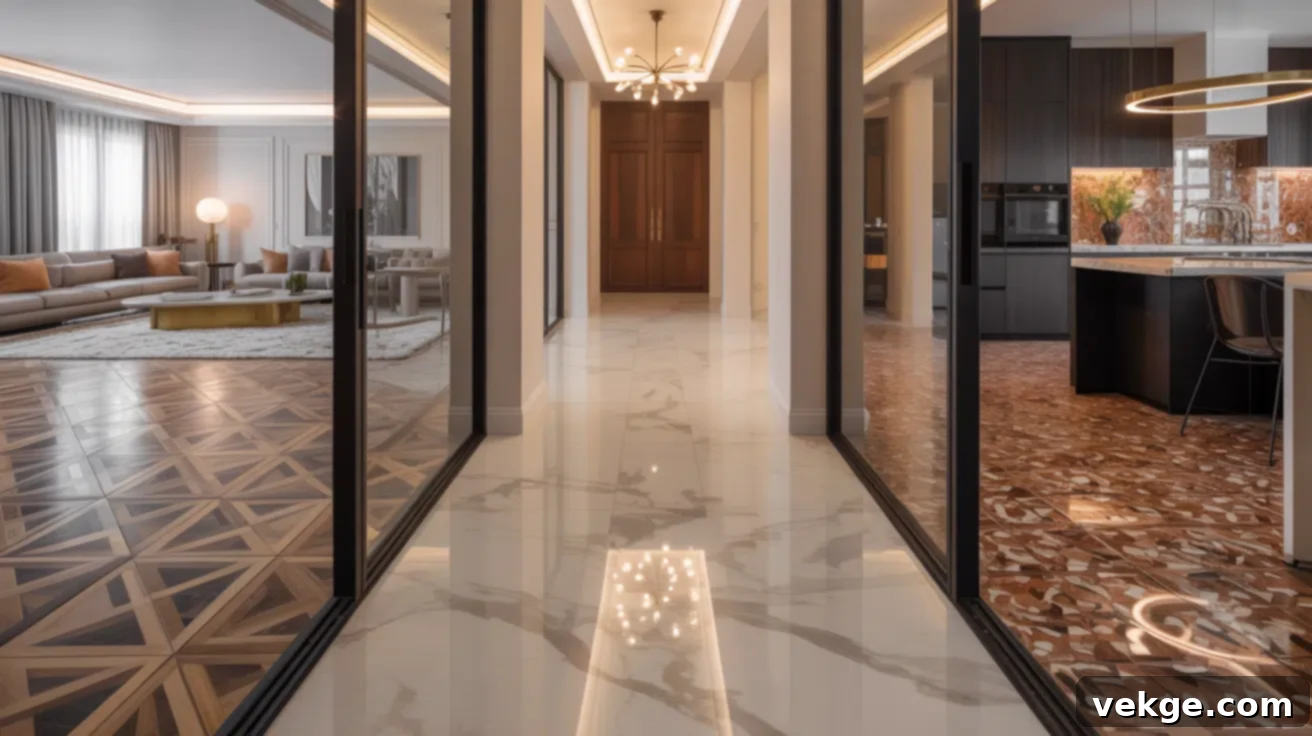The Ultimate Guide to Luxury Flooring: Exploring High-End Materials, Costs, and Value
Are you envisioning a home transformation, starting from the ground up? Perhaps you’re contemplating an upgrade to your floors, but the thought of a significant investment has you pausing. With an array of opulent flooring options available, ranging from exquisitely rare marbles to intricately hand-patterned woods, it’s easy to feel overwhelmed by choices and prices.
This comprehensive guide is designed to demystify the world of luxury flooring. We’ll delve into the factors that contribute to the high cost of certain floor types, helping you discern when investing in these premium materials offers unparalleled value and when more mid-range alternatives might be a more sensible choice for your specific needs.
Our aim is to empower you with the knowledge to balance aesthetic grandeur with practical considerations. By the end of this article, you’ll be better equipped to find the perfect flooring solution that not only complements your personal style but also aligns perfectly with your budget and lifestyle requirements.
What Makes Certain Flooring Options So Expensive?
The price tag associated with high-end flooring isn’t arbitrary; it’s a reflection of a combination of factors. These include the scarcity of the raw materials, the meticulous craftsmanship involved, limitations in supply chains, complex installation processes, and the ongoing commitment to maintenance and care.
Rare and Exclusive Materials
At the heart of expensive flooring lies the exclusivity of its constituent materials. Many luxury floors feature materials sourced from remote or geologically unique regions, such as rare hardwoods like the richly grained teak or the distinctly striped zebrawood, or exquisite natural stones like the pristine Italian Calacatta marble or the translucent onyx. These materials are inherently scarce, often requiring extensive search and retrieval processes, and their formation or growth cycles are incredibly slow. This inherent rarity directly translates into higher market prices due to limited availability and high demand.
Beyond natural elements, certain flooring options incorporate specialized components, such as custom-designed tiles embedded with precious shells, intricate metal inlays, or even ethically sourced diamonds. When materials are hard to come by and possess unique aesthetic qualities, their value—and thus their price—escalates significantly, making them a luxury desired by many but obtainable by few.
Unparalleled Skilled Craftsmanship
Another major contributor to the cost of premium flooring is the exceptional skill and artistry required in its creation and installation. Achieving the flawless finish and intricate details often associated with luxury floors demands expert craftsmanship. This can involve hand-cutting natural stone tiles to exact specifications, creating bespoke intricate inlays, or precisely laying complex custom wood patterns like Versailles parquet.
Such work cannot be mass-produced by machines; it requires the meticulous attention of highly trained artisans and specialists. These professionals possess years of experience, a keen eye for detail, and often utilize specialized tools and traditional techniques. When a floor is custom-designed and meticulously crafted to suit the unique contours and aesthetic vision of a specific home, the labor involved—both in terms of time and expertise—becomes a significant component of the final cost.
Limited Global Supply and Import Challenges
The global supply chain also plays a crucial role in determining the price of luxury flooring. Many highly sought-after flooring materials originate from specific regions or countries known for their unique natural resources. Acquiring and transporting these materials often involves complex logistics, significant time investments, and considerable financial outlays. If a source country has strict export quotas, if the material is environmentally protected, or if geopolitical factors restrict trade, the available supply diminishes, driving prices upward.
Furthermore, shipping heavy, fragile, or oversized materials over long distances incurs substantial freight costs, insurance fees, and often hefty import duties or taxes. These additional charges are passed on to the consumer. A limited global supply inevitably leads to increased competition among buyers, further escalating the market value of these exclusive flooring types.
Complex and Challenging Installation
The installation of luxury flooring is rarely a simple DIY task. Materials such as large-format natural stone slabs, delicate hand-laid mosaic tiles, or intricate custom hardwood patterns demand a high degree of precision and specialized expertise. Installation often requires a perfectly leveled subfloor, specialized adhesives and grouts, and meticulous measurements to ensure seamless transitions and perfect alignment.
Even premium hardwood flooring might require on-site sanding, custom staining, sealing, or precise pattern cutting. Mistakes during the installation process can be incredibly costly, potentially damaging expensive materials and compromising the entire aesthetic integrity of the floor. Because these installations are so labor-intensive and require such a high level of care and skill, the associated labor costs are significantly higher than for more conventional or snap-in flooring options.
Ongoing Care and Maintenance Requirements
The initial investment in luxury flooring is often just the beginning. Many high-end materials require consistent, specialized care to maintain their pristine appearance and extend their lifespan. For instance, natural stone floors like marble may need regular sealing (every few months to a few years, depending on traffic and use) to prevent staining and etching. Exotic hardwoods might require specific cleaning solutions, periodic polishing, or buffing to retain their luster.
Some delicate materials are prone to scratches, dents, or may not tolerate moisture or harsh chemicals well, necessitating specific cleaning protocols and protective measures. Over the years, the cumulative cost of these specialized cleaning products, professional maintenance services, and potential repairs can add a substantial amount to the total ownership cost, a factor that should always be considered when making an investment in luxury flooring.
The Most Exquisite and Expensive Flooring Types
To help you navigate the world of high-end floor coverings, we’ve categorized some of the most luxurious choices. This allows for easier comparison and helps you identify which material best aligns with the unique demands and aesthetic vision for your space, whether you prefer the timeless elegance of stone, the warmth of exotic wood, or truly unique surface treatments.
Rare Natural Stones: A Timeless Elegance
These natural stones are celebrated globally for their unparalleled beauty, distinctive color palettes, and unique textures. Many are sourced from exclusive international quarries and demand specialized handling, installation, and ongoing maintenance, including regular sealing to protect their pristine surfaces.
1. Calacatta Gold Marble
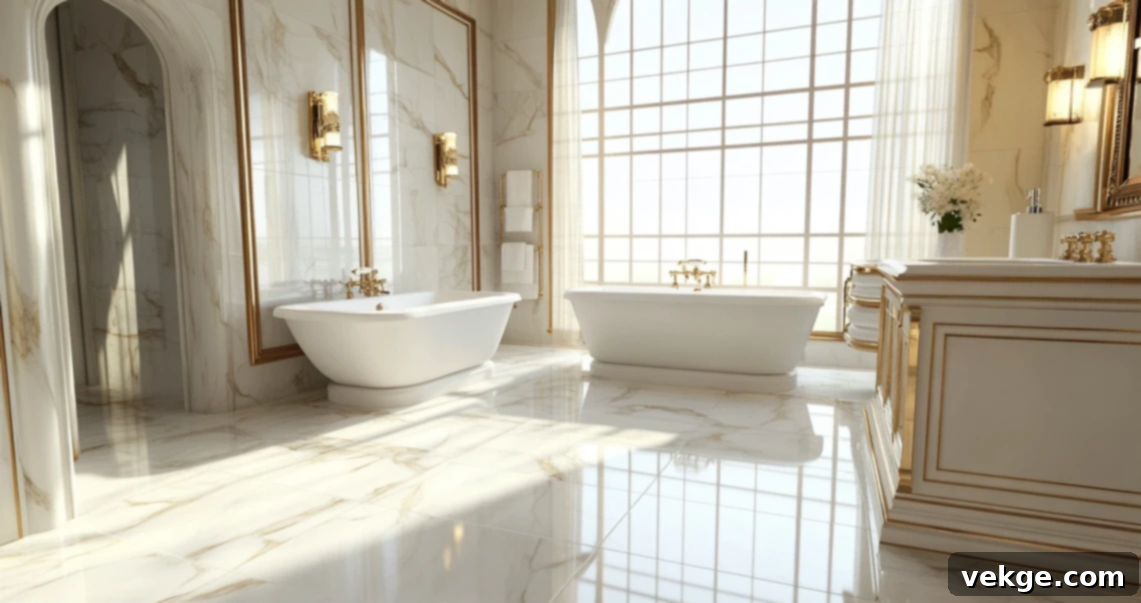
Originating from the Apuan Mountains in Carrara, Italy, Calacatta Gold Marble is renowned for its bright white background adorned with dramatic, thick veining in shades of gold and deep gray. This rare and highly coveted stone instantly elevates the sophistication of any interior, making it a popular choice for luxurious bathrooms, grand entryways, and elegant dining rooms. Its soft, luminous appearance exudes an undeniable sense of wealth and refinement. However, its porous nature requires diligent sealing to prevent staining, adding to its overall cost of ownership due to both its rarity and its specific upkeep needs.
2. Thassos White Marble
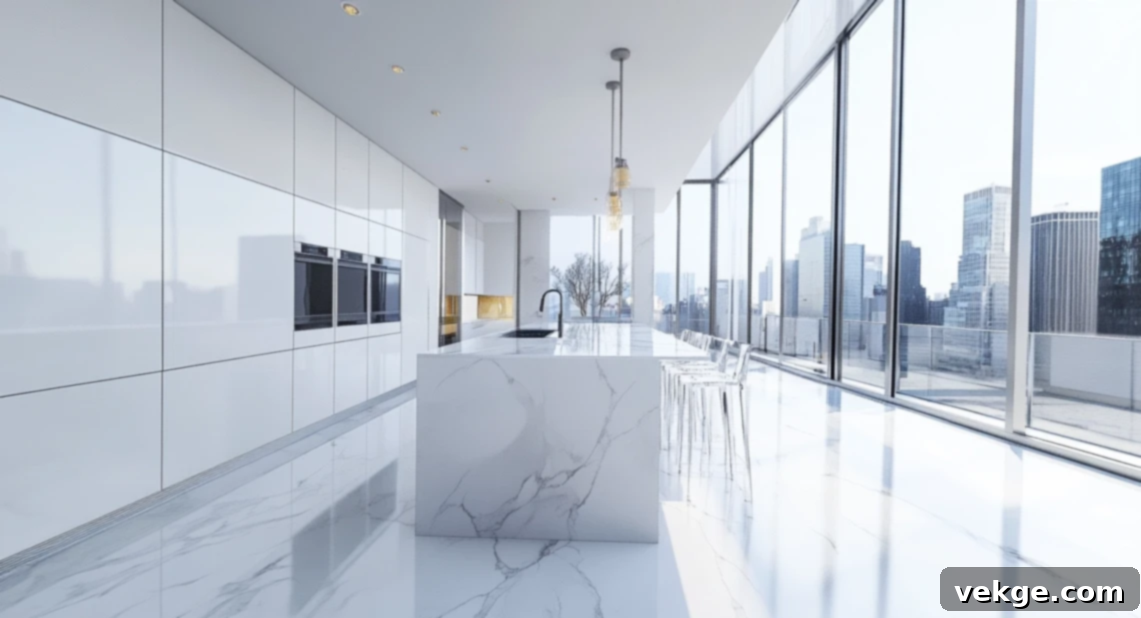
Mined exclusively from the island of Thassos in Greece, Thassos White Marble is celebrated as one of the purest and whitest natural stones available globally. Unlike other marbles, it typically exhibits minimal to no veining, offering a crisp, uniform appearance that radiates light. This luminous quality makes it an exceptional choice for making smaller spaces feel expansive and brighter, perfectly suited for modern minimalist designs or classic, pristine aesthetics in bathrooms and kitchens. Regular cleaning and sealing are essential to maintain its immaculate surface, providing a sharp, polished foundation for both contemporary and traditional home styles.
3. Blue Bahia Granite
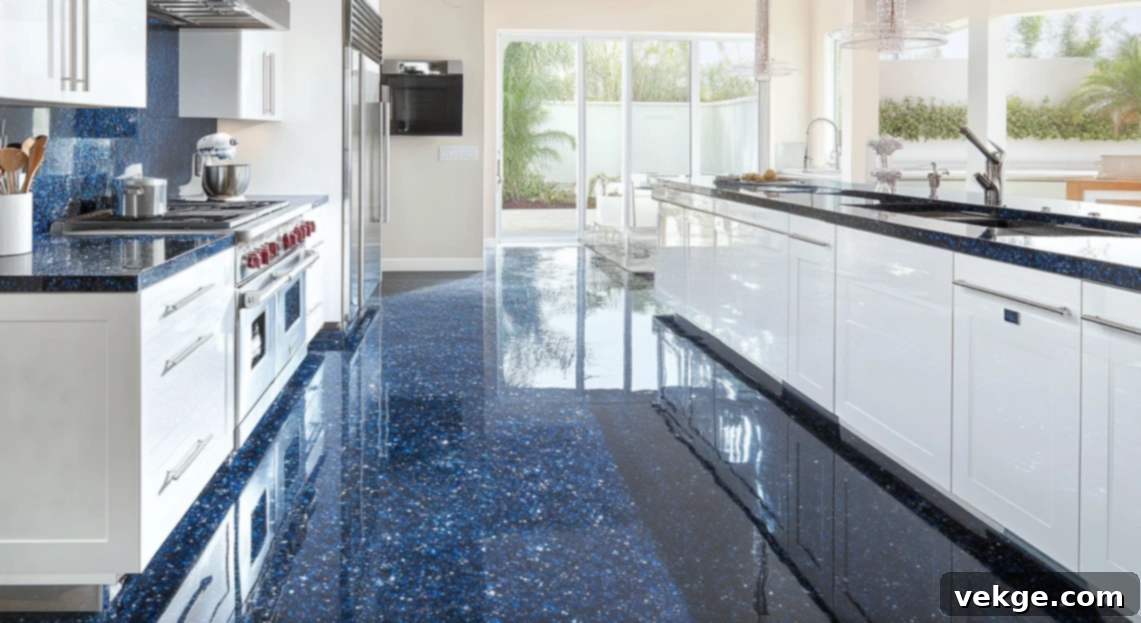
Hailing from the quarries of Bahia, Brazil, Blue Bahia Granite is a truly striking and dramatic stone, characterized by its intensely rich blue tones often flecked with captivating swirls of white, black, and sometimes even gold or green, creating a galaxy-like effect. It stands out as one of the rarest colored granites in the world. Its exceptional durability and resistance to scratches, heat, and moisture make it an ideal—albeit premium—choice for high-traffic areas like kitchens, high-end commercial spaces, or areas prone to water exposure. While its initial price is substantial, its low maintenance requirements once installed and its ability to infuse a vibrant, unique character into any space make it a favored option for those seeking a bold statement.
4. Onyx & Quartzite Tiles
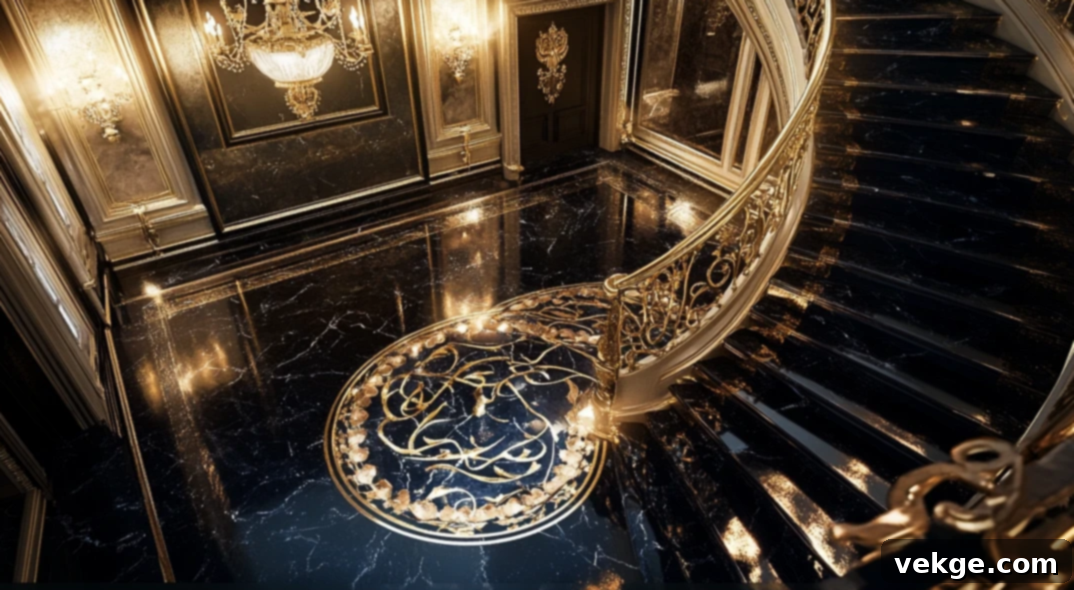
Onyx and Quartzite offer distinct qualities for luxury flooring. Onyx, known for its stunning translucence and vibrant, often banded colors, creates a truly dramatic effect, especially when backlit. However, it is a softer, more fragile stone requiring frequent sealing and is best reserved for low-traffic, visually impactful areas like feature walls, powder rooms, or decorative floor inlays. Quartzite, on the other hand, is significantly harder and more durable, offering the elegant appearance of marble but with granite-like strength, making it suitable for busier areas like kitchen floors and countertops. The cost for both depends heavily on factors such as thickness, finish quality, and the specific geological origin of the stone, each bringing a unique form of natural artistry to a space.
Exotic Hardwood and Wood-Inspired Options: Warmth and Character
These luxurious wood and wood-inspired flooring types are prized for their deep, rich colors, distinctive grain patterns, and the unparalleled warmth and character they bring to an interior. They transform floors into captivating focal points within any room.
5. Zebra Wood
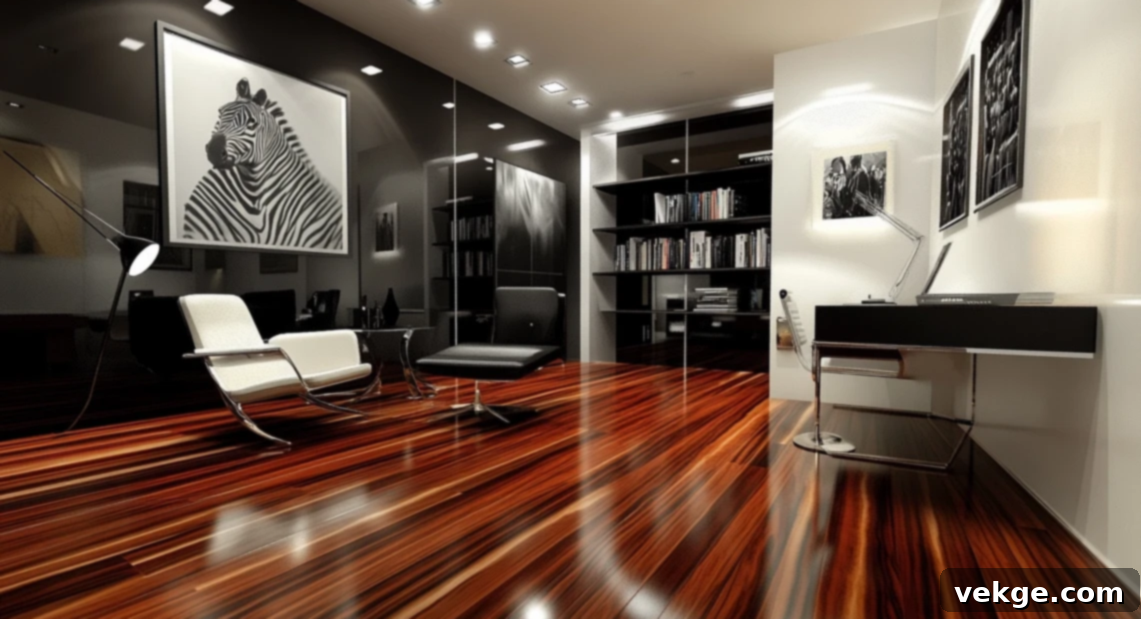
Zebrawood, true to its name, features a striking alternating pattern of dark brown to black stripes against a creamy, golden-brown background, resembling a zebra’s coat. Sourced primarily from West Africa, this exotic hardwood is both rare and highly sought after for its dramatic visual appeal. It possesses significant hardness and density, making it a durable choice for areas like executive offices, formal living rooms, or grand hallways where its unique pattern can be fully appreciated. To maintain its lustrous sheen and protect its distinctive stripes, Zebrawood requires regular polishing and careful protection from excessive moisture or abrasive dirt, which can dull its vibrant appearance. Thus, it thrives best in dry, controlled, and relatively low-traffic environments.
6. Bubinga & Bocote
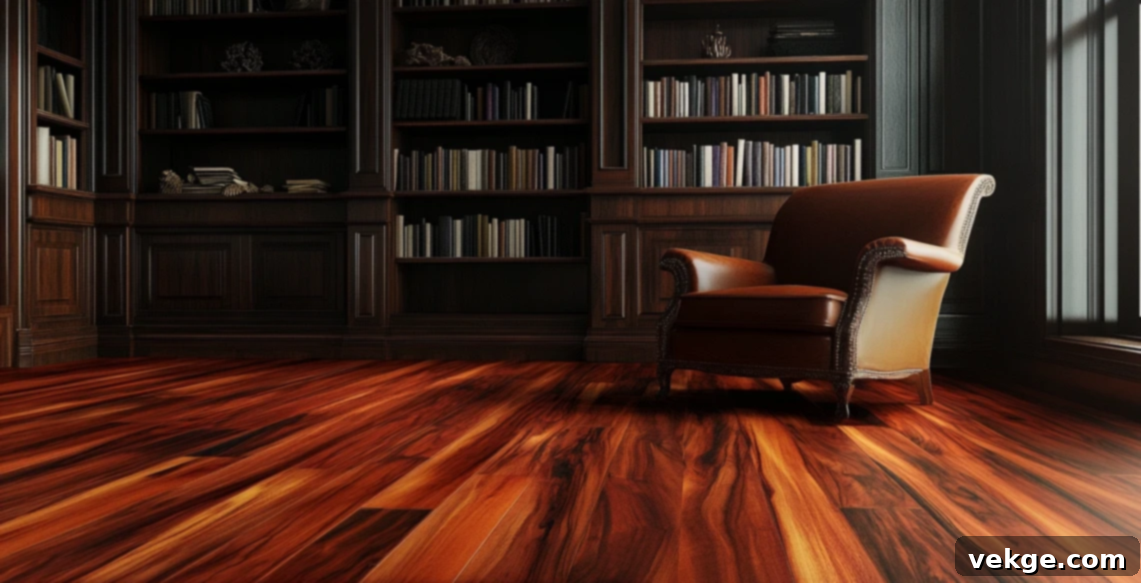
Bubinga, an African hardwood, is known for its beautiful pinkish-red to reddish-brown heartwood, often with purplish streaks and a fine, interlocking grain that creates an iridescent shimmer. Bocote, from Central and South America (primarily Mexico), is instantly recognizable by its wild, often dramatic grain patterns with dark brown to black lines against a yellowish-brown background. Both woods are exceptionally dense, heavy, and remarkably durable, making them ideal for high-end custom flooring applications in stately homes or exclusive private rooms. Their premium cost stems from the slow growth rate of the trees, the difficulty in harvesting, and the challenges associated with milling and working with such dense materials. The expertise required for installation is high, but the resulting floor is a truly unique and lasting work of art.
7. Versailles Parquet
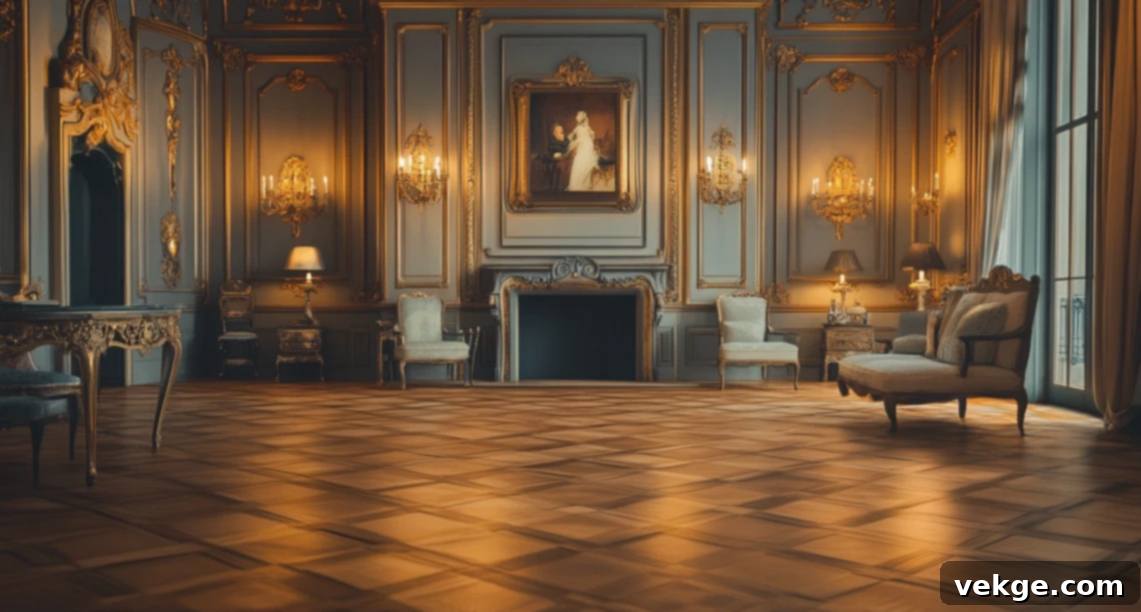
The Versailles parquet pattern is a timeless classic, evoking the grandeur of French palaces and châteaux, particularly the Palace of Versailles from which it takes its name. This sophisticated wood floor design is created by meticulously arranging small, precisely cut wood pieces into an intricate, interlocking square pattern, often featuring diagonal or woven elements within each square. The installation process is exceptionally labor-intensive, requiring exact measurements, intricate cuts, and highly skilled planning and execution to achieve its signature symmetrical elegance. Due to the complex nature of its design and the significant labor involved in its installation, Versailles parquet remains one of the most costly and formal wood flooring options, perfectly suited for majestic dining rooms, expansive living areas, or grand ballrooms.
8. Reclaimed Antique Hardwood
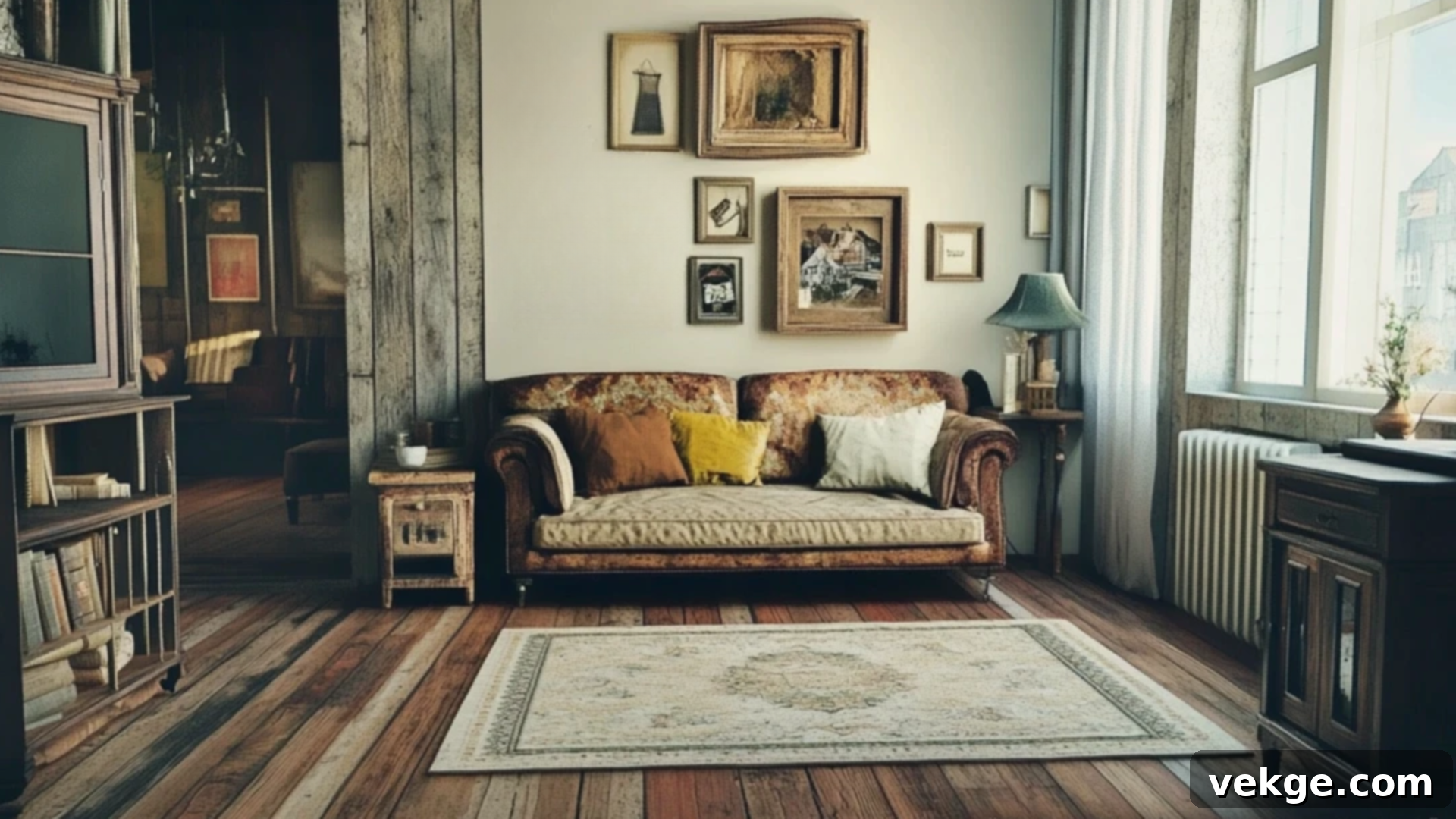
Reclaimed antique hardwood flooring is not merely recycled wood; it is timber salvaged from historic structures such as old homes, venerable barns, retired factories, or even decommissioned ships. Each plank carries the authentic marks of its past—original nail holes, saw marks, natural weathering, and a deeply rich, aged patina that new wood simply cannot replicate. This flooring option is highly valued for its unique character, its historical narrative, and its significant eco-friendly appeal, as it diverts material from landfills and reduces the demand for new timber. Beyond its charm, reclaimed wood often boasts superior stability and strength compared to newly milled lumber due to centuries of natural seasoning. While it requires expert sanding and sealing to prepare for a new life, it delivers an unparalleled warmth and a sense of lived-in history to any space.
9. Petrified Wood

Petrified wood represents a fascinating fusion of wood and stone. It is fossilized wood where all the organic materials have been replaced by minerals (like silica) over millions of years, while retaining the original structure of the tree. Each individual tile or slab of petrified wood is utterly unique, displaying the intricate grain patterns of the ancient tree transformed into a material as hard and durable as rock. The resulting palette often includes a rich array of earthy tones—browns, grays, creams, and reds—making it an exceptional choice for distinctive entryways, luxurious spa-like bathrooms, or feature floors in a study. While it benefits from sealing, it offers incredible longevity and resistance to wear, making it a truly one-of-a-kind, durable, and beautiful investment for a luxury interior.
Unique Luxury Surfaces: Beyond Traditional Expectations
These extraordinary materials push the boundaries of conventional flooring, offering rare textures, captivating colors, and intricate handmade details that result in truly standout and artistic floor surfaces.
10. LuxTouch Diamond Marble
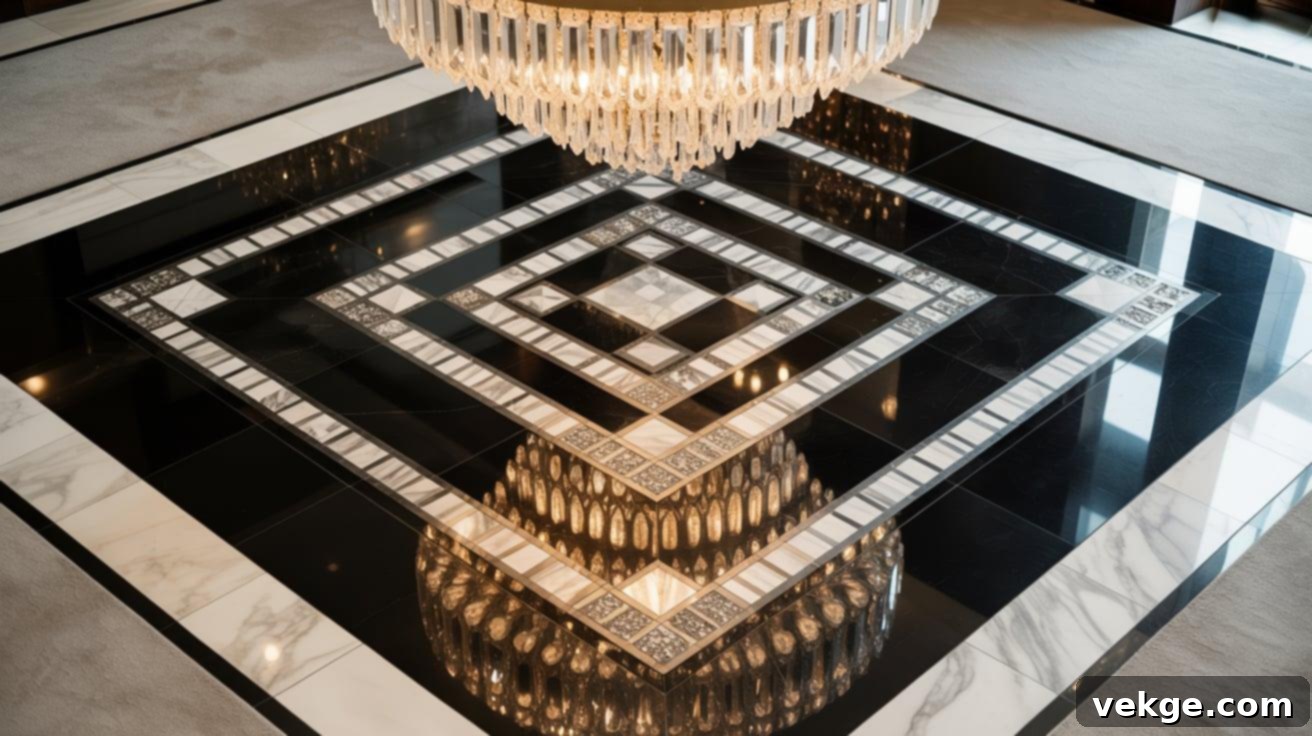
Representing the pinnacle of opulent flooring, LuxTouch Diamond Marble transcends mere utility to become a work of art. This extraordinary surface meticulously integrates tiny, ethically sourced diamonds, shimmering mother-of-pearl, and rich black natural stone into a high-grade marble matrix. Each tile is painstakingly handcrafted, a process that requires unparalleled precision and artistry, contributing to a price tag that often rivals or exceeds the cost of an entire luxury home. Such a floor is typically found not in residential settings, but in ultra-exclusive showrooms, high-fashion boutiques, or custom-commissioned installations for the world’s most discerning clientele. Its extreme rarity and bespoke nature make it one of the most exclusive and costly flooring options imaginable.
11. Handcast Bronze Flooring
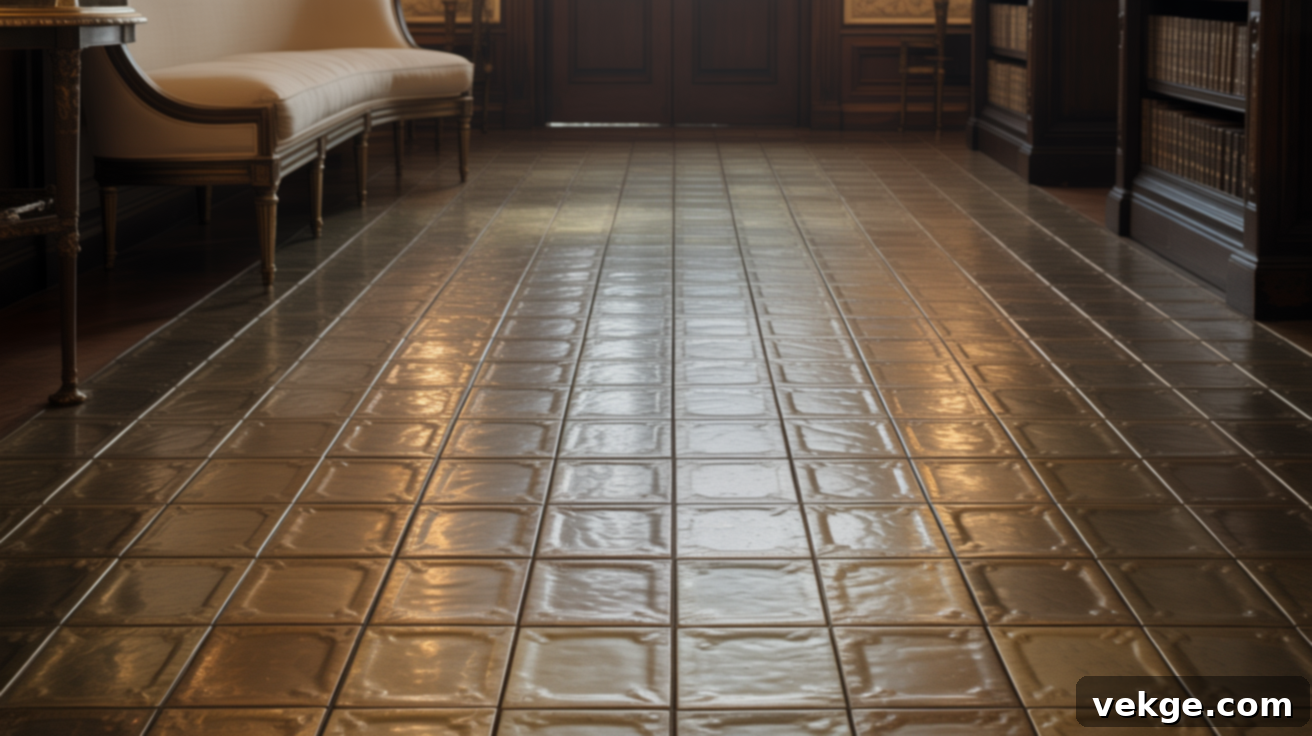
Handcast bronze tiles or panels offer a deeply luxurious and distinctive flooring surface. Each individual piece is poured and meticulously finished by hand, resulting in subtle variations in texture and a rich, glowing metallic warmth that develops a unique patina over time. The inherent strength and durability of bronze make it exceptionally resistant to wear, making it an excellent choice for formal spaces such as grand foyers, elegant libraries, exclusive wine cellars, or sophisticated commercial interiors. While the material cost and the labor-intensive casting process contribute to its high price, the floor’s ability to develop character and age gracefully is highly valued. Professional installation and a regular wax finish are typically required to maintain its exquisite appearance and enhance its developing patina.
12. Leather Flooring
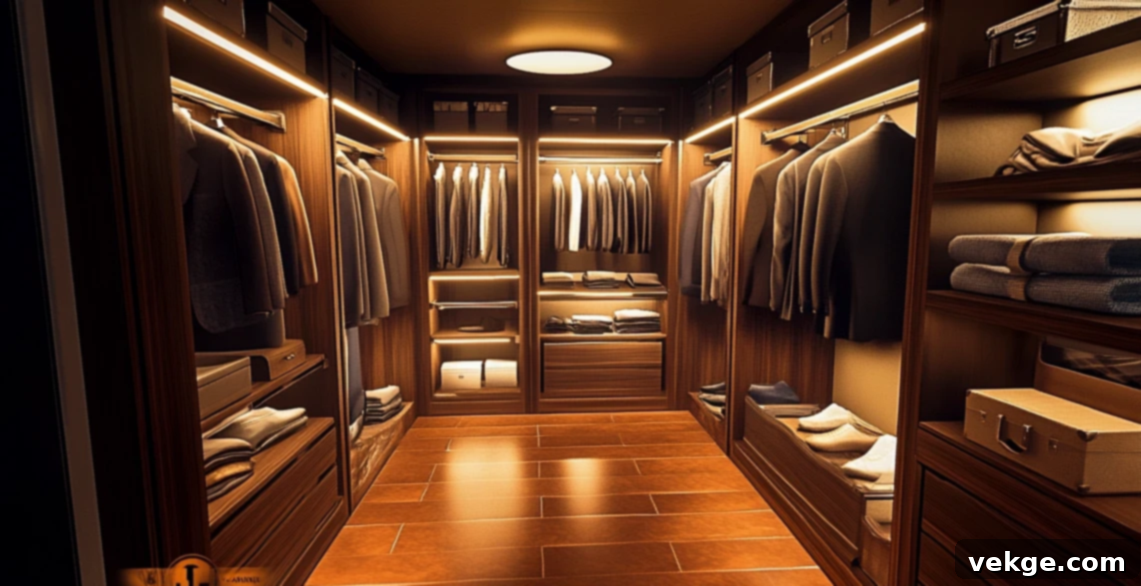
Crafted from genuine leather tiles, this flooring option provides an incredibly soft, warm, and inviting surface underfoot. It’s a unique choice that introduces a tactile luxury and a sense of cozy indulgence. Leather flooring is best suited for intimate, low-traffic areas where comfort and acoustic properties are paramount, such as master bedrooms, dressing rooms, walk-in closets, or sophisticated private studies. However, its delicate nature means it scratches easily and is highly susceptible to water damage, making it unsuitable for busy areas, kitchens, or bathrooms. While offering a distinctively rich and comfortable ambiance, leather floors demand consistent and gentle care to preserve their smooth texture and elegant appearance.
13. Designer Mosaic Tiles
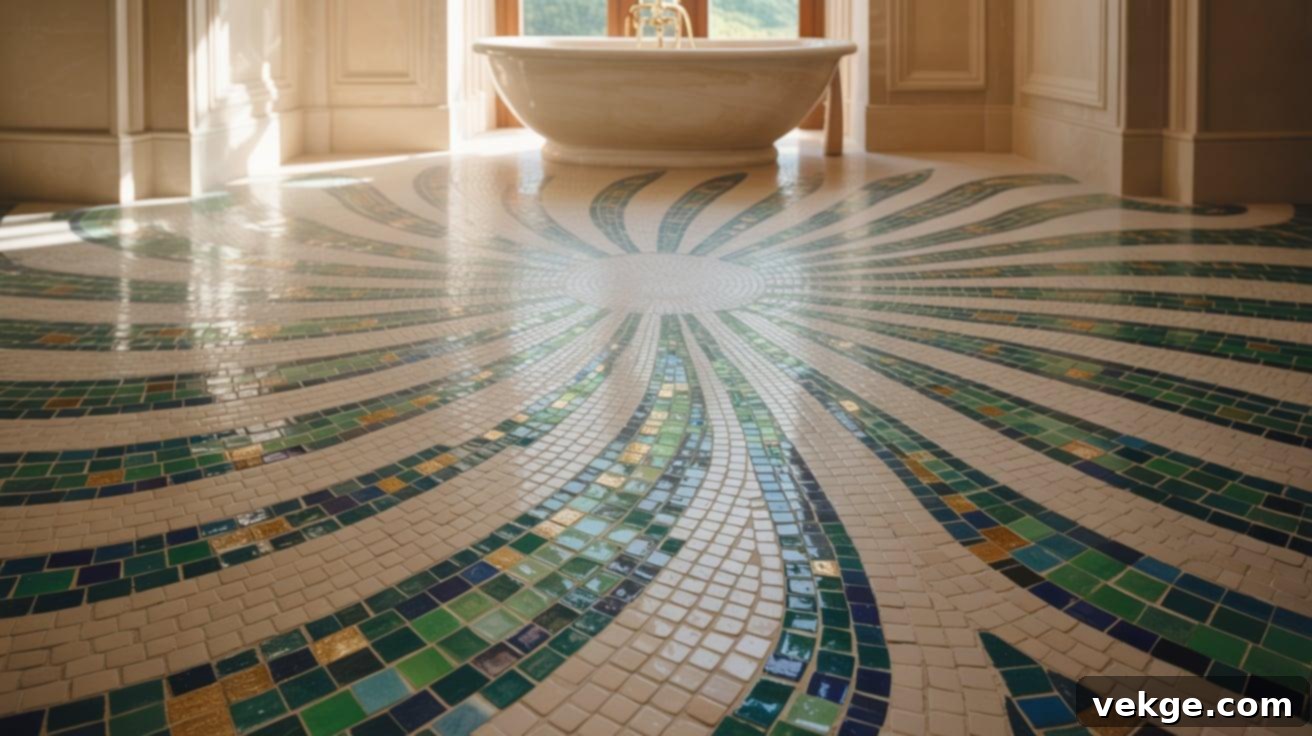
Designer mosaic tiles represent a true art form in flooring. These exquisite tiles can be handcrafted from an array of materials, including fine ceramic, glass, natural stone, or even metals, often featuring vibrant colors, intricate patterns, and sometimes bespoke painted designs. The creation and installation of such a floor is a highly specialized and time-consuming process, as each tiny tessera (individual piece) is carefully placed by hand to form the desired image or pattern. This bespoke artistry and intense labor significantly contribute to their premium cost. Exceptionally durable and water-resistant, designer mosaic tiles are particularly effective in bathrooms, kitchens, or entryways, transforming even small areas into breathtaking, unique design statements that reflect individual taste and artistic flair.
14. Terrazzo with Brass or Copper Inlays
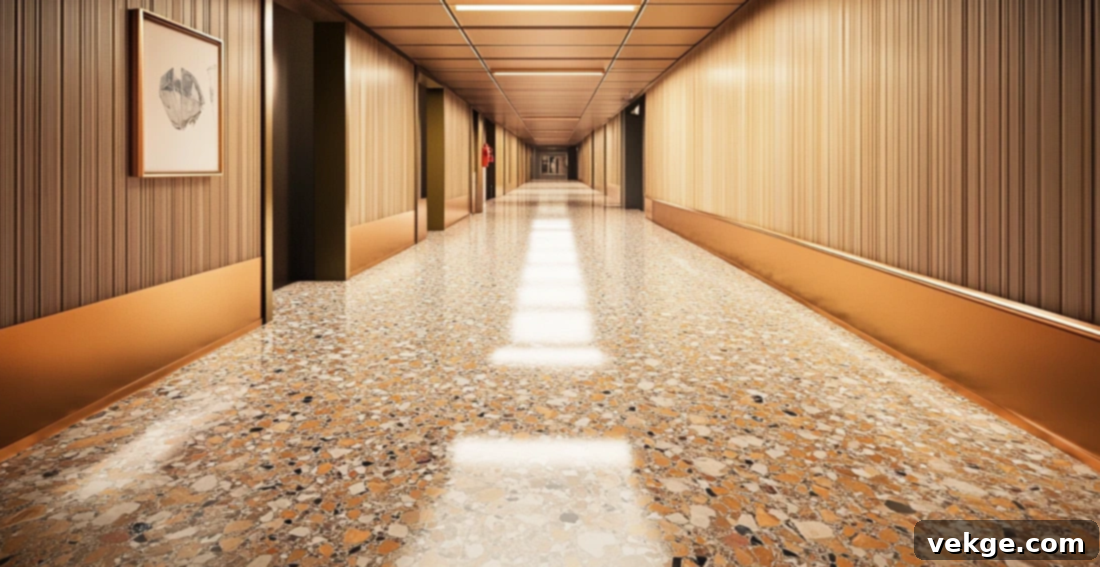
Terrazzo flooring, a composite material known for its incredible durability and striking appearance, traditionally consists of marble, quartz, granite, or glass chips set within a binder and then ground and polished to a smooth finish. Elevating this classic material to a new level of luxury involves incorporating custom brass or copper strips into the design. These metallic inlays not only serve as decorative accents, outlining patterns or creating geometric shapes, but also add a sophisticated shimmer and a distinct high-end aesthetic. Terrazzo floors are exceptionally robust, long-lasting, and remarkably easy to clean, making them ideal for expansive areas in both residential and commercial settings, such as grand hallways, upscale offices, or modernist living spaces. The combination of industrial strength with artistic metallic detailing delivers a polished, refined feel that is both contemporary and timeless.
15. Mother-of-Pearl Tile Inlays
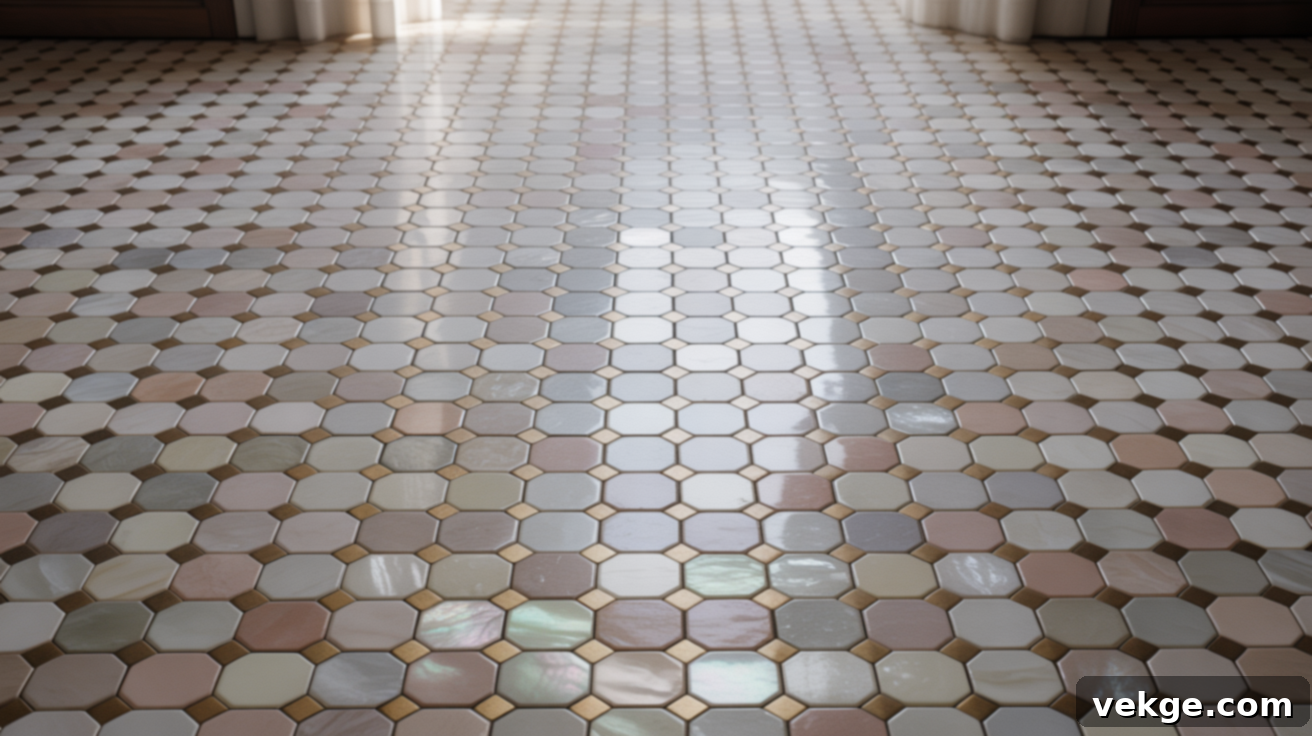
Mother-of-pearl tiles are exquisite, luminous surfaces crafted from the iridescent inner layer of mollusk shells, such as oysters and abalones. These delicate tiles shimmer with a natural array of soft, ethereal colors, including creamy whites, subtle pinks, silvers, and blues, creating a gentle, pearlescent glow that is truly captivating. They are typically reserved for highly special and low-traffic areas where their delicate beauty can be preserved and admired, such as luxurious powder rooms, elegant vanity surrounds, or decorative entry hall inlays. Each tile is painstakingly handmade, contributing to its inherent value and fragility. While not suitable for high-traffic zones, mother-of-pearl inlays infuse a space with unparalleled beauty, sophisticated charm, and an impressive touch of organic luxury.
Best Luxury Flooring by Room Type: Matching Elegance with Function
Selecting the ideal luxury floor isn’t just about its beauty; it’s about matching its inherent characteristics with the functional demands and aesthetic goals of each specific room. Some premium materials excel in bustling environments, while others are best preserved for quieter, more intimate spaces. Here’s a tailored guide to help you pair luxury flooring with the room where it will truly flourish.
Kitchen
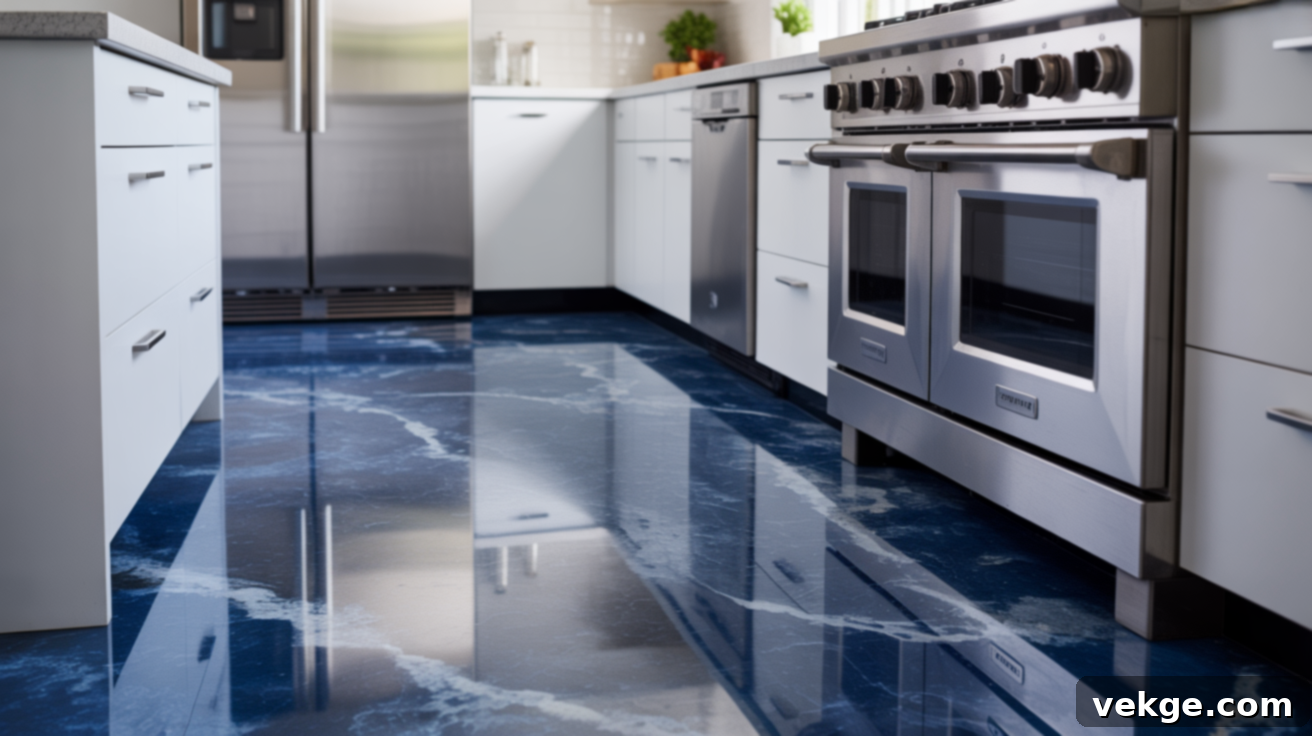
Kitchens are high-traffic, high-activity zones that demand resilient, easily cleanable flooring. Blue Bahia Granite is an exceptional choice, offering not only a bold and unique aesthetic but also superior resistance to stains, scratches, and moisture—qualities essential for a busy cooking space. Its striking blue tones can become a vibrant focal point. Alternatively, Terrazzo with brass or copper inlays provides an incredibly durable, smooth surface that stands up to heavy use and spills. It’s effortlessly wiped clean, offers excellent longevity, and adds a sophisticated, polished look perfect for large, modern kitchen designs.
Bathroom

Bathrooms are defined by humidity and potential water exposure, making material selection critical. Thassos White Marble is an exquisite option that delivers a bright, pristine, and clean aesthetic. Its pure white hue makes small bathrooms feel significantly more spacious and luminous, creating a spa-like sanctuary. For those seeking more artistic expression, Designer Mosaic Tiles are an excellent choice. They are highly water-resistant and allow for intricate patterns, vibrant colors, or bespoke designs that can transform a simple bathroom into a stunning, personalized artistic statement, seamlessly blending functionality with unparalleled style.
Entryway
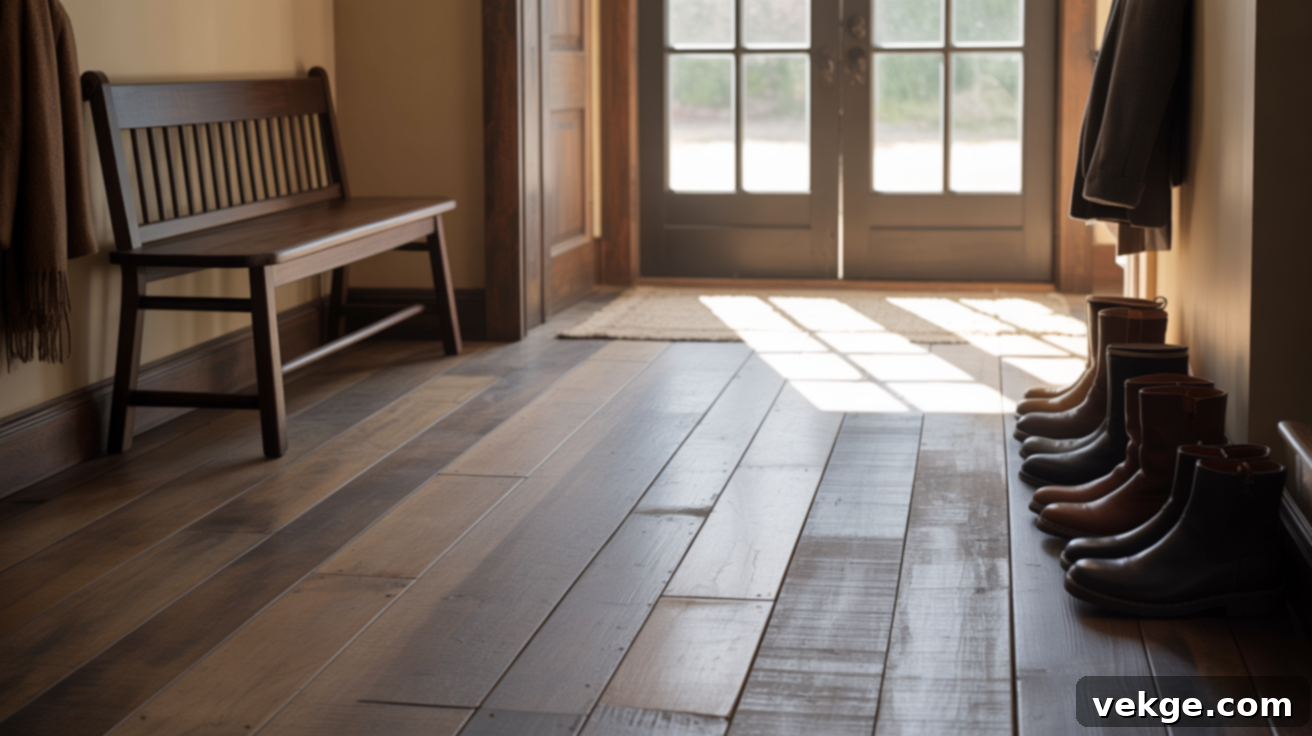
The entryway is the first impression of your home, setting the aesthetic tone and bearing the brunt of daily foot traffic, dirt, and outdoor elements. Reclaimed Antique Hardwood adds immediate warmth, character, and a sense of history, creating a welcoming and grounded atmosphere. Its inherent durability, often superior to new wood, makes it resilient against wear and tear. Alternatively, Quartzite provides exceptional strength and resistance to scratches, abrasions, and dirt, making it a robust choice that can withstand heavy foot traffic from shoes and outdoor debris. Both options make strong initial statements, combining beauty with the necessary resilience for a frequently used space.
Bedroom

Bedrooms are personal sanctuaries designed for comfort and tranquility, typically experiencing lower traffic. Handcast Bronze Tiles can introduce a unique blend of warmth and subtle metallic sheen. Each handmade tile ages beautifully, developing a rich patina over time that adds depth and character, perfect for creating a cozy and sophisticated ambiance. While it requires occasional wax upkeep, its distinctive look provides a luxurious foundation. Leather flooring is another indulgent option, offering an incredibly soft, warm surface underfoot that enhances the feeling of comfort and luxury in a private, low-traffic bedroom setting. Both choices contribute to an atmosphere of refined relaxation.
Living Room
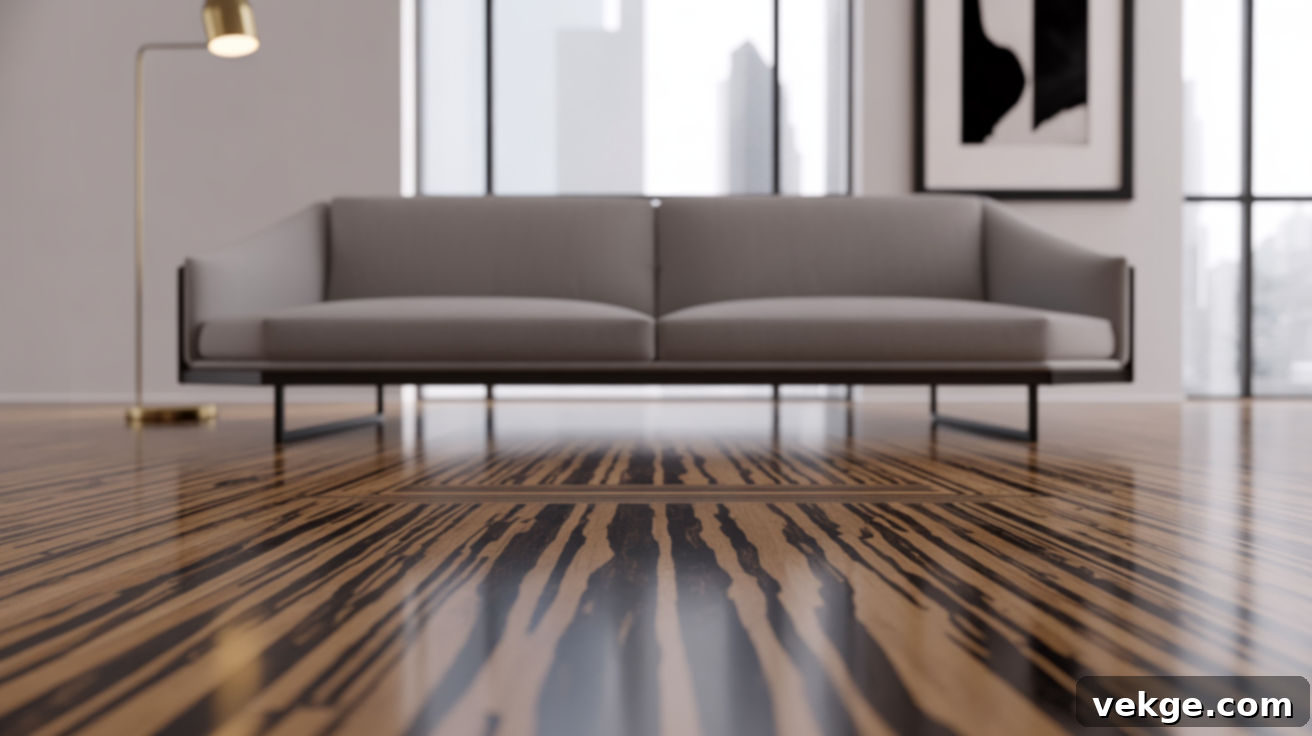
Living rooms are central gathering spaces for relaxation and entertainment, deserving of flooring that combines aesthetic appeal with durability. Versailles Parquet immediately imbues a space with a sense of formal elegance and historical grandeur. Its intricate geometric patterns become a captivating design feature, drawing the eye and adding architectural interest. For a more exotic and contemporary flair, Zebra Wood flooring offers striking visual drama with its bold, contrasting stripes. It transforms the floor itself into a magnificent design element, making the living room an unforgettable space. Both options provide a luxurious backdrop for socializing and quiet evenings alike.
Dining Room
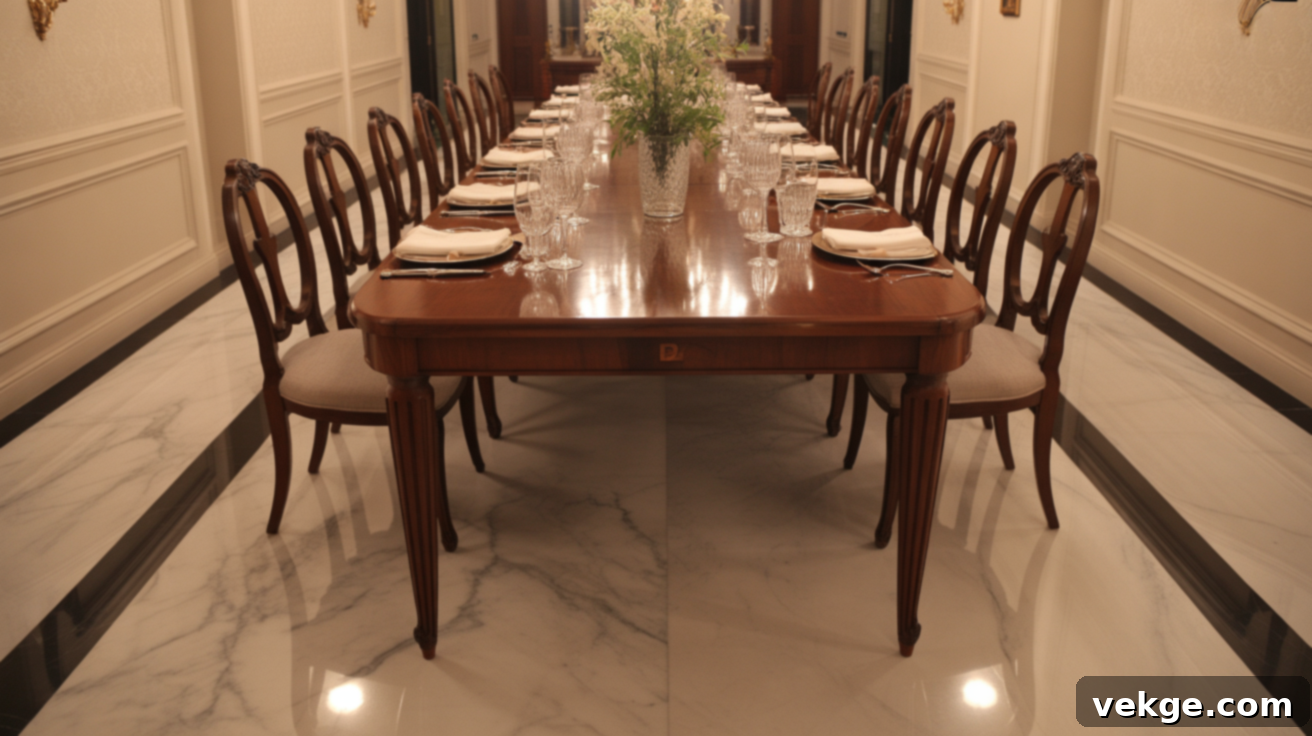
Dining rooms often call for a sense of refinement and occasion, making luxurious flooring an ideal complement to formal settings. Calacatta Gold Marble delivers a clean, polished, and exceptionally elegant foundation. Its bright white base with distinctive gold and gray veining perfectly harmonizes with sophisticated dining furniture, enhancing the room’s formal ambiance. Alternatively, for those who prefer the warmth of wood, Bocote Wood offers profound depth and dramatic character. Its rich, dark grains and natural sheen create an opulent and inviting atmosphere, providing a striking contrast or harmonious backdrop for memorable dining experiences.
Understanding the True Cost of Luxury Flooring
The investment in luxury flooring extends far beyond the initial price per square foot of the material itself. The total cost is a multifaceted calculation that encompasses specialized installation expertise, the inherent difficulty of working with premium materials, and the ongoing financial commitment required to maintain their pristine appearance over time. Understanding these components is crucial for a realistic budget and long-term satisfaction.
Average Price Ranges and Material Variability
Luxury flooring materials occupy a wide spectrum of price points, primarily influenced by their rarity, geographical origin, the complexity of their extraction or manufacturing process, and their intrinsic aesthetic value. For instance, basic natural stone tiles might start around $10-20 per square foot, but rare marbles like Calacatta Gold or exotic granites like Blue Bahia can easily exceed $50-100 per square foot, and even higher for large slabs or custom cuts. Exotic hardwoods like Zebrawood or Bubinga can range from $15-40 per square foot, while highly specialized options like petrified wood or handcast bronze can command prices upwards of $100-300 per square foot, depending on the supplier and specifics. Handmade designer mosaic tiles or floors with diamond/mother-of-pearl inlays can enter the realm of bespoke art, with costs soaring into the hundreds or even thousands per square foot. The “base cost” is merely the starting point; factors like desired finish, thickness, and design complexity will significantly influence the final material price.
The Critical Role of Labor and Installation Costs
For most luxury flooring, the cost of labor and installation can often equal or even surpass the material cost. Premium materials demand installation by highly skilled and experienced professionals. This isn’t just about laying tiles or planks; it involves intricate processes such as meticulous subfloor preparation (leveling, moisture barriers), precise pattern matching (especially for Versailles parquet or complex mosaics), custom cutting for awkward spaces, and the use of specialized adhesives and sealing techniques. The fragility of some stones, the weight of others, or the unique characteristics of exotic woods all require a delicate touch and profound understanding. Any misstep can result in damaged, expensive materials or a compromised aesthetic. Therefore, investing in certified, expert installers is not just recommended but often a necessity for high-end floors, driving labor costs significantly higher than for standard flooring types.
Hidden Maintenance and Long-Term Expenses
The financial commitment to luxury flooring doesn’t conclude once the installation is complete. Many premium floors require a commitment to ongoing, specialized maintenance that can accumulate into substantial expenses over their lifespan. This can include regular professional cleaning services for specific materials, periodic resealing for natural stones like marble or onyx, specialized buffing and polishing for certain hardwoods or metal floors, and the purchase of specific, pH-neutral cleaning agents. Some materials may also require climate control (e.g., humidity regulation for exotic woods) to prevent warping or cracking. Furthermore, accidental damage or wear may necessitate professional repair services, which for rare materials can be particularly costly. Factoring in these hidden maintenance expenses is crucial for a realistic long-term budget and ensuring your luxury floor retains its initial splendor for decades to come.
Sustainable Luxury: Eco-Friendly Flooring Alternatives
For those who desire the elegance and quality of luxury flooring without compromising their commitment to environmental responsibility, a growing number of eco-friendly options offer beauty, comfort, and durability with a significantly reduced ecological footprint. These choices allow you to create a stunning, high-end interior that is also kind to the planet.
- Sustainable Hardwoods: Opt for hardwoods sourced from responsibly managed forests, certified by organizations like the Forest Stewardship Council (FSC). Options like fast-growing bamboo or FSC-certified oak and maple provide robust, stylish, and renewable flooring solutions. These options ensure that timber is harvested in a way that protects biodiversity and sustains forest ecosystems for future generations.
- Reclaimed Wood: As discussed, reclaimed wood is salvaged from old buildings, barns, or even underwater sources. This practice not only gives new life to beautiful, seasoned timber but also reduces demand for newly harvested wood and minimizes waste. Each plank tells a unique story, adding unparalleled character and a rich, historical warmth to any room, making it a truly unique and sustainable luxury.
- Natural Linoleum: Far from its synthetic counterpart, natural linoleum is made from a blend of biodegradable materials including solidified linseed oil, pine rosin, wood flour, cork dust, and mineral fillers, pressed onto a jute backing. It is durable, naturally antibacterial, soft underfoot, and offers excellent resilience, making it a superb, eco-conscious choice for kitchens, playrooms, or even commercial spaces.
- Recycled Tile: A diverse category that includes glass, ceramic, and porcelain tiles made from post-consumer or post-industrial waste materials. These tiles are incredibly durable, highly water-resistant, and come in a vast array of colors, patterns, and finishes, allowing for creative and unique designs. Choosing recycled tiles reduces landfill waste and the energy consumption associated with manufacturing new materials.
- Low-VOC Finishes: Regardless of the flooring material you choose, opting for low-VOC (Volatile Organic Compound) paints, stains, and sealers is a critical step towards creating an eco-friendly and healthier indoor environment. These finishes release fewer harmful chemicals into the air, improving indoor air quality and ensuring a safer space for your family and pets.
Final Thoughts on Your Luxury Flooring Investment
Choosing the perfect flooring for your home is a significant decision, and when it comes to luxury options, it’s about much more than just the initial expenditure. It’s about making a discerning choice that harmonizes with your personal goals, the specific characteristics of your space, and your day-to-day lifestyle. We’ve thoroughly explored what elevates certain flooring materials to the luxury tier, when their premium price point translates into undeniable value, and how even mid-range alternatives can deliver exceptional style and functionality without compromise.
Whether your project involves a subtle refresh of a single room or an ambitious, complete home renovation, we sincerely hope this comprehensive guide has empowered you with newfound confidence and clarity in your decision-making process. If you find yourself still deliberating, a practical approach is to begin small; consider upgrading one key area, allowing you to experience the chosen material firsthand and see how it integrates into your home’s flow and your daily routine.
As you plan your investment, always remember to look beyond the immediate surface. Consider the long-term comfort, the commitment to care, and how your chosen flooring will function and enhance your home’s aesthetic and practical needs over many years. For more insightful tips and expert advice, be sure to explore our other detailed guides before taking your next transformative step.
